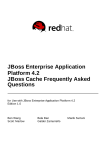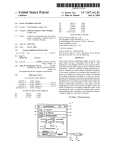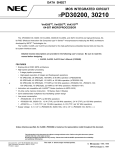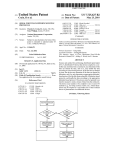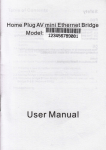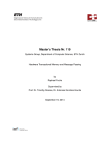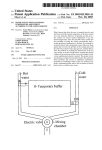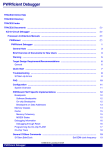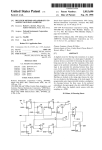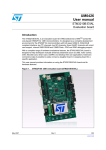Download L1 flush mechanism to flush cache for power down and handle
Transcript
US008171326B2 (12) United States Patent Keller et al. (54) (56) L1 FLUSH MECHANISM TO FLUSH CACHE FOR POWER DOWN AND HANDLE COHERENCE DURING FLUSH AND/OR AFTER POWER DOWN U.S. PATENT DOCUMENTS 5,632,038 A 5,784,628 A 5,903,908 A (US); Tse-Yu Yeh, Cupertino, CA (US); Ramesh Gunna, San Jose, CA (US); Brian J. Campbell, Sunnyvale, CA (US) (73) Assignee: Apple Inc., Cupertino, CA (US) Notice: *May 1, 2012 References Cited (75) Inventors: James B. Keller, Redwood City, CA (*) US 8,171,326 B2 (10) Patent N0.: (45) Date of Patent: 5/1997 Fuller 7/1998 Reneris 5/1999 Singh et al. 6,021,474 A 2/2000 Milling 6,125,450 6,571,333 6,760,819 6,782,472 9/2000 5/2003 7/2004 8/2004 Kardach Jain et al. Dhong et al. Jain et al. 9/2004 Dai ............................. .. 713/320 A B1 B2 B2 6,792,551 B2 * 6,976,181 B2 * 12/2005 Dai et a1. 7,164,610 B2 * Subject to any disclaimer, the term of this patent is extended or adjusted under 35 USC 154(b) by 135 days. 1/2007 713/320 Kimura et al. .............. .. 365/195 7,325,100 B2 1/2008 Dhiman et al. 7,752,474 B2 * 7/2010 Keller et al. ................ .. 713/324 OTHER PUBLICATIONS This patent is subject to a terminal dis claimer. Intel, “Pentium Family User’s Manual,” Chapter 30, “Power Man agement”, vol. 1: Data Book, ISBN: l-555l2-225-6, 1994, pp. l-ll. (21) Appl. N0.: 12/7s5,s42 (22) Filed: * cited by examiner May 24, 2010 Primary Examiner * Chun Cao (65) Prior Publication Data US 2010/0235670 A1 (74) Attorney, Agent, or Firm * Lawrence J. Merkel; Meyertons, Hood, Kivlin, KoWert & GoetZel, PC. Sep. 16, 2010 (57) Related US. Application Data (63) Continuation of application No. 11/525,584, ?led on Sep. 22, 2006, noW Pat. No. 7,752,474. (51) Int. Cl. (52) (58) US. Cl. G06F 1/32 ABSTRACT In one embodiment, a processor comprises a data cache con ?gured to store a plurality of cache blocks and a control unit coupled to the data cache. The control unit is con?gured to ?ush the plurality of cache blocks from the data cache respon sive to an indication that the processor is to transition to a loW poWer state in Which one or more clocks for the processor are (2006.01) ..................................................... .. 713/324 inhibited. Field of Classi?cation Search ................ .. 713/324, 7 1 3/3 23 20 Claims, 4 Drawing Sheets See application ?le for complete search history. I. ____________________ __ Processor 25: | <-I-> Power Management Unit & i <—> I Core 2 I I | | 1 I l I | I l » I : I I I I I I I I I | | | 1 | l l | l | | I l l l I l 1 | l | | | | | | | | | | | l | | I I I I I I I Done I | I | l | | I I | | | I : : I || I | l I I I I I l. ____________________________ I | I MRB Data g :I II | MRB Addr 44 l \ I | I Snoop Tag Q I EvictI I AddrI I I I | 1 Interface Unit I I : _________________________________________ _ _ 1 "Data IIAddr to/?om Interconnect 20 Resp US. Patent May 1, 2012 Processor @ A Addr RespI v Sheet 1 014 US 8,171,326 B2 Processor L2 Cache E I I l2_B DataI Interconnect Q . Memory 1/0 Bndge E Controller E i I US. Patent May 1, 2012 Sheet 3 014 US 8,171,326 B2 Sleep Request Start -- Flush Transmit Current /— 80 Index, Way I Signal Done if /— 82 Last Index, Way I 84 Increment Way '7 86 Yes we Record Last Index, Way 92 No v 90 Increment Index End -- Flush 88 N0 US. Patent May 1, 2012 Sheet 4 M4 US 8,171,326 B2 100 Enter Sleep State? Yes V 102 — Request Core Quiesce, Assert Sleep Req. Flush and Core Done? 104 Yes r—-—- 106 Inhibit Processor Clocks US 8,171,326 B2 1 2 L1 FLUSH MECHANISM TO FLUSH CACHE FOR POWER DOWN AND HANDLE COHERENCE DURING FLUSH AND/OR AFTER POWER DOWN unit coupled to the data cache. The control unit is con?gured to ?ush the plurality of cache blocks from the data cache responsive to an indication that the processor is to transition to a loW poWer state in Which one or more clocks for the processor are inhibited. This application is a continuation of US. application Ser. No. 11/525,584, Which Was ?led on Sep. 22, 2006, now US. In another embodiment, a system comprises a processor comprising a data cache con?gured to store a plurality of cache blocks and a secondary cache coupled to the processor. Pat. No. 7,752,474. The processor is con?gured to ?ush the plurality of cache BACKGROUND blocks from the data cache responsive to an indication that the 1. Field of the Invention This invention is related to the ?eld of processors and, more processor is to transition to a loW poWer state in Which one or more clocks for the processor are inhibited. The ?ush com particularly, to handling caches and cache coherency in poWer prises Writing any modi?ed cache blocks of the plurality of management modes in processors. 2. Description of the Related Art As the poWer consumption of processors has increased, implementation of poWer management modes in processors cache blocks to the secondary cache. In yet another embodiment, a method comprises determin ing that a processor is to transition to a loW poWer state in Which one or more clocks used by the processor are inhibited; has become increasing important. In many systems, the poWer supply is at least sometimes a battery or other stored charge supply. Maximizing battery life in such systems is 20 often a key selling feature. Additionally, even in systems that have effectively limitless poWer (e. g. systems plugged into a Wall outlet), the challenges of cooling the processors and other circuits in the system may be reduced if the processors can be placed in loW poWer modes When full processing cessor is to transition to the loW poWer state. BRIEF DESCRIPTION OF THE DRAWINGS 25 poWer is not needed. A variety of poWer management schemes are in use. Typi cally, the processor may be operated in one of a set of poWer states. The highest poWer state is the state in Which the pro cessor executes at its maximum operating frequency, typi cally supplied by the highest supply voltage used in any of the and ?ushing a plurality of cache blocks from a data cache Within the processor responsive to determining that the pro 30 The folloWing detailed description makes reference to the accompanying draWings, Which are noW brie?y described. FIG. 1 is a block diagram of one embodiment of a system. FIG. 2 is a block diagram of one embodiment of a proces sor shoWn in FIG. 1. FIG. 3 is a block diagram of one embodiment of a state machine for ?ushing the data cache shoWn in FIG. 2. FIG. 4 is a ?owchart illustrating operation in one of the poWer states. In some cases, other poWer states are de?ned in Which the processor operates at loWer operating frequencies and/ or loWer supply voltages (or the loWer frequencies/volt states shoWn in FIG. 3 for one embodiment. FIG. 5 is a ?owchart illustrating operation of one embodi ages may be used Without actually causing a poWer state transition). Additionally, one or more loWer poWer states are 35 ment of the processor in transitioning to a loW poWer state. typically de?ned in Which the processor clocks are inhibited (also referred to as disabled the clocks or “turning off’ the clocks). Since the processor clocks are not toggling, logic in the processor does not change state and the poWer consumed by the processor may be largely reduced. In some loW poWer 40 states, the processor is still supplied With supply voltage to permit the state of the processor, including any caches, to be retained even though the clocks are disabled. In other loW poWer states, the supply voltage may be deactivated as Well and the processor state is lost. Typically, the processor must 45 DETAILED DESCRIPTION OF EMBODIMENTS be reset from a loW poWer state in Which the processor’s supply voltage Was deactivated. A challenge in processors that implement loW poWer states in Which the supply voltage is maintained, and thus the caches retain their state, is the maintenance of coherency in the System OvervieW 50 caches With respect to any memory transactions that may be generated by other devices/processors While the processor is in the loW poWer state. In some cases, systems “Wake up” the processor to a higher poWer state to perform a snoop (and then return the processor to the loW poWer state). PoWer is con sumed in Waking up the processor, often for a snoop that does not hit in the cache. In other cases, the processor is designed to continue clocking the cache and a portion of the processor that interfaces to the cache during the loW poWer states. The cache and related circuitry is thus in a different clock domain than the rest of the processor, Which complicates the overall 55 Turning noW to FIG. 1, a block diagram of one embodiment of a system 10 is shoWn. In the illustrated embodiment, the system 10 includes processors 12A-12B, a level 2 (L2) cache 14, an I/O bridge 16, a memory controller 18, and an inter connect 20. The processors 12A-12B, the L2 cache 14, the I/O bridge 16, and the memory controller 18 are coupled to the interconnect 20. More particularly, as illustrated With regard to the processor 12A, the agent coupled to the interconnect 20 may communicate via transactions having address, response, 60 and data phases on the interconnect 20. While the illustrated embodiment includes tWo processors 12A-12B, other embodiments of the system 10 may include one processor or more than tWo processors. Similarly, other embodiments may include more than one L2 cache 14, more than one I/O bridge processor design. SUMMARY 16, and/ or more than one memory controller 18. In one 65 In one embodiment, a processor comprises a data cache con?gured to store a plurality of cache blocks and a control While the invention is susceptible to various modi?cations and alternative forms, speci?c embodiments thereof are shoWn by Way of example in the draWings and Will herein be described in detail. It should be understood, hoWever, that the draWings and detailed description thereto are not intended to limit the invention to the particular form disclosed, but on the contrary, the intention is to cover all modi?cations, equiva lents and alternatives falling Within the spirit and scope of the present invention as de?ned by the appended claims. embodiment, the system 10 may be integrated onto a single integrated circuit chip (eg a system on a chip con?guration). In other embodiments, the system 10 may comprise tWo or US 8,171,326 B2 3 4 more integrated circuit components coupled together via a circuit board. Any level of integration may be implemented in various embodiments. In the illustrated embodiment, cache coherent communi cation is supported on the interconnect 20 via the address, 12A-12B may include circuitry that executes the instructions de?ned in the instruction set architecture. In one embodi response, and data phases of transactions on the interconnect ment, the processors 12A-12B implement the PoWerPCTM instruction set architecture. HoWever, other embodiments may implement any instruction set architecture (e. g. MIPSTM, SPARCTM, x86 (also knoWn as Intel Architecture-32, or 20. Generally, a transaction is initiated by transmitting the IA-32), IA-64, ARMTM, etc.). address of the transaction in an address phase, along With a command indicating Which transaction is being initiated and The processors 12A-12B may each include a data cache, and may also be con?gured to enter a loW poWer state in various other control information. Cache coherent agents on the interconnect 20 use the response phase to maintain cache Which one or more clocks used by the processor are inhibited. When a processor 12A-12B is to transition to the loW poWer coherency. Each coherent agent responds With an indication of the state of the cache block addressed by the address, and cannot be determined or for other reasons. Retried transac state, the processor 12A-12B may be con?gured to ?ush the data cache. Flushing the data cache may include Writing any cache blocks that have been modi?ed by the processor in the cache (and thus the copy in the memory system and/or the L2 tions are cancelled, and may be reattempted later by the initiating agent. The order of successful (non-retried) address processor. Flushing may also include invalidating the cache phases on the interconnect 20 may establish the order of transactions for coherency purposes. The data for a transac blocks in the cache, in some embodiments. In other embodi ments, the cache block states may be changed to another state, may also retry transactions for Which a coherent response tion is transmitted in the data phase. Some transactions may cache 14, if any, is not the most recent copy) out of the 20 be used solely to establish a change in the coherency state of a cached block. Generally, the coherency state for a cache block may de?ne the permissible operations that the caching agent may perform on the cache block (e.g. reads, Writes, etc.). Common coherency state schemes include the modi ?ed, exclusive, shared, invalid (MESI) scheme, the MOESI scheme Which includes an oWned state in addition to the MESI states, and variations on these schemes. Generally, a cache block may refer to a contiguous block of data Which is the unit of allocation and deallocation in the caches Within the system. The cache blocks may be aligned to cache block boundaries in the memory system. In some embodiments, coherency is maintained by the agents on the interconnect 20 snooping transactions and 25 30 35 checking for cached copies of the transactions. In other embodiments, coherency may be maintained through the transmission of explicit probe commands on the interconnect 20, to Which targeted agents respond based on their cache state. In either case, the maintenance of coherency may involve responding to external communication and pos sibly changing cache state responsive to the external commu nication. Snooping Will be used as an example beloW, but state. Furthermore, if the cache blocks are invalidated or changed to a state that is knoWn externally (eg by the L2 cache 14), the processor 12A-12B need not respond to snoops (or probes) at all. Accordingly, the clocks to the processor may be disabled, including the clocks to the data cache and corresponding snoop circuitry. For example, in one embodi ment, the processors 12A-12B may implement a duplicate set of cache tags for coherency purposes (referred to as “snoop tags”). The snoop tags may be disabled along With the rest of the processor 12A-12B. Accordingly, the processor 12A-12B need not have separate clock domains to keep the coherency maintenance circuitry/ data cache active in the loW poWer state, in some embodiments, although a processor 12A-12B may implement multiple clock domains for other reasons. Furthermore, the processor 12A-12B need not be Woken up 40 from the loW poWer state to respond to a snoop, in some embodiments. In some embodiments, the loW poWer state may also include deactivating the poWer supply. Since the modi?ed explicit probes may be used in other embodiments. The interconnect 20 may have any structure. For example, the interconnect 20 may have separate address, response, and data interfaces to permit split transactions on the interconnect 20. The interconnect 20 may support separate address and data arbitration among the agents, permitting data phases of 45 transactions to occur out of order With respect to the corre 50 sponding address phases. Other embodiments may have in order data phases With respect to the corresponding address phase. In one implementation, the address phase may com prise an address packet that includes the address, command, and other control information. The address packet may be such as shared, as described in more detail beloW. Since the modi?ed cache blocks have been Written out of the processor 12A-12B, the processor 12A-12B need not be able to supply data for any memory transactions that may subsequently occur While the processor is in the loW poWer not include a data phase. For example, some transactions may cache blocks have been Written back to the L2 cache 14 or other memory external to the processor 12A-12B, no data is lo st from the data cache When the poWer supply is deactivated. The L2 cache 14 may be an external level 2 cache, Where the data and instruction caches in the processors 12A-12B are level 1 (L1) caches. In one implementation, the L2 cache 14 may be a victim cache for cache blocks evicted from the L1 caches. The L2 cache 14 may have any construction (e.g. direct mapped, set associative, etc.). The modi?ed cache blocks ?ushed from the processors 12A-12B When entering a loW poWer state may be Written to 55 the L2 cache 14, in one embodiment. Accordingly, the latency to reload the ?ushed blocks into the data cache of the proces sors 12A-12B after returning to a high poWer state may be the transmitted in one bus clock cycle, in one embodiment. In one particular implementation, the address interconnect may include a centraliZed arbiter/address sWitch to Which each latency of an L2 cache hit, assuming the blocks remain stored source agent (e.g. processors 12A-12B, L2 cache 14, and I/O bridge 16) may transmit address requests. The arbiter/address sWitch may arbitrate among the requests and drive the request in the L2 cache 14 at the time the processors 12A-12B Wake from the arbitration Winner onto the address interconnect. In one implementation, the data interconnect may comprise a limited crossbar in Which data bus segments are selectively coupled to drive the data from data source to data sink. The processors 12A-12B may comprise circuitry imple menting an instruction set architecture. That is, the processors 60 up. Additionally, in embodiments that implement the system 10 as a system on a chip, Writing the modi?ed cache blocks to the L2 cache 14 may consume less poWer than Writing the blocks to the external (off chip) memory. 65 A loW poWer state may refer to any state that the processor 12A-12B may enter that is designed to consume less poWer than the normal state of executing at full speed in the proces sor. Such states may be referred to as sleep states, and the term 5 6 sleep state Will be used as an example herein. Other terms cache 34 may comprise a plurality of cache block storage locations, Where each cache block storage location is con?g used for loW power states include nap, deep sleep, power doWn, etc. ured to store a cache block. In the illustrated embodiment, each cache block storage location comprises a memory loca tion in the cache tags memory 38 and a memory location in the data memory 40. The cache tags memory 38 stores a tag The U0 bridge 16 may be a bridge to various I/O devices or interfaces (not shown in FIG. 1). Generally, the I/O bridge 16 may be con?gured to receive transactions from the I/O devices or interfaces and to generate corresponding transac tions on the interconnect 20. Similarly, the I/O bridge 16 may locating the corresponding cache block in memory. The tag may generally include a portion of the address that excludes the cache offset portion and the portion used to index the data cache 34, in set associative or direct mapped embodiments. The cache tags memory 38 may also store the cache coher receive transactions on the interconnect 20 that are to be delivered to the I/O devices or interfaces, and may generate corresponding transactions to the I/O device/interface. In some embodiments, the I/O bridge 16 may also include direct ency state (eg MESI state or MOESI state, in some embodi ments), validity of the cache block, replacement data such as least recently used (LRU) state, etc. The data memory 40 may memory access (DMA) functionality. The memory controller 18 may be con?gured to manage a main memory system (not shoWn in FIG. 1). The memory in the main memory system may comprise any desired type of memory. For example, various types of dynamic random store the cache block of data. The cache tags memory 38 may detect a hit or miss in response to a cache access, and may provide controls to the cache data memory 40 to read/Write access memory (DRAM) such as synchronous DRAM (SDRAM), double data rate (DDR) SDRAM, etc. may form the main memory system. The processors 12A-12B may gen 20 erally fetch instructions from the main memory system, and sor 12A. That is, the core 32 may include the circuitry that may operate on data stored in the main memory system. I/O devices may use the main memory system to communicate With the processors 12A-12B (eg via DMA operations or individual read/Write transactions). Processor Turning next to FIG. 2, a block diagram of one embodiment of the processor 12A is shoWn. The processor 12B may be similar. In the embodiment of FIG. 2, the processor 12A includes a poWer management unit 30, a core 32, a data cache 34, and an interface unit 36. The poWer management unit 30 is coupled to one or more external signals received by the processor 12A, and is coupled to the core 32 and the interface unit 36. The core 32 is coupled to the data cache 34, Which is coupled to the interface unit 36. The data cache 34 comprises fetches, decodes, executes, and Writes results of the instruc 25 data to the core 32 (for a read). In the event of a cache miss, a 30 35 unit 36 comprises a ?ush control unit 42, a memory request buffer (MRB) address buffer 44, an MRB data buffer 46, a 40 45 50 55 detail beloW. The MRB address buffer 44 may subsequently transmit the snoop address (or the index and Way of the cache storage location that is hit by the snoop, as determined from the snoop tag 48). If the snoop hits a dirty (modi?ed) cache block in the data cache 34, the cache tag memory 38 may assert the snoop hit dirty signal (Snp Hit Dirty in FIG. 2) to the 60 MRB address buffer 44 and may direct the data memory 40 to output the modi?ed cache block to the MRB data buffer 46. It is noted that, While the snoop address input to the data cache 34 (through the mux 50) is illustrated separately from the vide a snoop hit signal to the ?ush control unit 42 and to the MRB address buffer 44. The interface unit 36 is further coupled to receive and provide snoop responses on the response portion of the interconnect 20. The data cache 34, in the illustrated embodiment, includes the cache tag memory 38 and the data memory 40. The data block stored in the data cache 34 is detected. That is, the snoop tags 48 may be duplicate cache tags for the cache tag memory 38, used for snooping purposes. If no snoop hit is detected, the interface unit 3 6 may generate an appropriate response for the snooped transaction. If a snoop hit is detected, the interface unit 36 may generate the response and the MRB address buffer 44 may queue the snoop address (responsive to the snoop hit signal from the snoop tag 48). The ?ush control unit 42 may also receive the snoop hit signal, as described in more the MRB address buffer 44 to receive a snoop address, and an input from the ?ush control unit 42 to receive a ?ush index and Way. The mux select control is provided by the ?ush control unit 42. The MRB data buffer 46 is coupled to receive and provide data from/to the data memory 40 and to receive and provide data on the data portion of the interconnect 20. The snoop tag 48 is coupled to receive an address from the address portion of the interconnect 20, and the MRB address buffer 44 is coupled to receive and transmit addresses on the address portion. The snoop tag 48 is further coupled to pro provide the evict data to the MRB data buffer 46 from the data memory 40. For snoop operations from the interconnect 20, the snoop tag 48 may be checked to determine if a snoop hit on a cache event of a hit in the data cache 34) to/from the core 32. The cache tag memory 38 is further coupled to receive snoop addresses (and ?ush address info) from the mux 50 and to provide a snoop hit dirty indication and evict address to the MRB address buffer 44. The mux 50 has an input coupled to ?ll request for the data cache 34 may be queued in the MRB address buffer 44, and the missing cache block may be ?lled to the data cache 34. When the missing cache block is ?lled into the data cache 34, another cache block may be evicted from the data cache 34. The data cache 34 may provide the evict address (shoWn as Evict Addr in FIG. 2) to the MRB address buffer 44. The same path may be used for miss addresses and for cache blocks being Written back in response to a snoop, in some embodiments. The data cache 34 may also unit 42 and to receive a done signal from the ?ush control unit 42. The core 32 is con?gured to transmit memory requests to the data cache 34 (and more particularly to the cache tag memory 38). The cache tag memory 38 is coupled to the data memory 40, Which is coupled to provide/receive data (in the tions in the instruction set. The core 32 may generate read and Write cache accesses to the data cache 34 (eg in response to executing load/ store operations de?ned in the instruction set architecture). In the event of a cache hit, the data cache 34 may update With data from the core 32 (for a Write) or provide a cache tag memory 38 and a data memory 40. The interface snoop tag 48, and a multiplexor (mux) 50. In the illustrated embodiment, the poWer management unit 30 is con?gured to transmit a sleep request signal (sleep req.) to the ?ush control the appropriate data memory location. The core 32 generally includes the circuitry that imple ments instruction processing in the processor 12A, according to the instruction set architecture implemented by the proces input of the core 32 to the cache tags memory 38, the snoop and core accesses may share a port on the data cache 34/cache 65 tag memory 38, in some embodiments. The ?ush control unit 42 may share the path to the data cache 34 With the snoop address from the MRB address buffer 44, through the mux 50 in the illustrated embodiment. Gen 7 8 erally, the power management unit 30 may detect that a tran sition to sleep state is desired (eg from external inputs to the that cause invalidation. The processor 12A may transition to a higher poWer state if such a snoop occurs. Alternatively, the power management unit 30, through internal monitoring by L2 cache 14 or other external circuitry may be con?gured to the poWer management unit 30, or a combination of external queue one or more invalidating snoops for presentation to the input and internal monitoring, in various embodiments). If a transition to sleep state is desired, the poWer management unit processor 12A upon transition to the higher poWer state, and the processor 12A may be transitioned to the higher poWer state temporarily if the queue ?lls. In yet another alternative, the L2 cache 14 may be con?gured to tag cache blocks that Were ?ushed from the data cache 34 but retained in shared state and may detect snoop invalidations to such cache blocks 30 may communicate With the core 32 to cause the core 32 to quiesce instruction execution and may also communicate With the ?ush control unit 42 to indicate that the transition to sleep state is to occur. For example, in the illustrated embodi ment, the poWer management unit 30 may assert the sleep request signal to the ?ush control unit 42. for queuing or to transition to the processor 12A to a higher poWer state for servicing the snoop. In still another altema tive, the L2 cache 14 or other external circuitry may detect a snoop invalidate (or a snoop hit invalidate) and may cause the entire data cache 34 to be invalidated When the processor 12A Responsive to the assertion of the sleep request signal, the ?ush control unit 42 may ?ush the data cache 34 of the cache blocks stored therein. More particularly, the ?ush control unit 42 may generate a plurality of requests to the data cache 34. Each request may access a different cache block storage transitions to a higher poWer state. location in the data cache 34 and may cause a ?ush of the cache block stored therein, if any. The data cache 34 may respond, for cache block storage locations that store modi?ed 20 cache blocks, by asserting the snoop hit dirty signal and providing the address of the modi?ed cache block as the evict address to the MRB address buffer 44. The cache block data may be provided to the MRB data buffer 46 from the data memory 40 as Well. The data cache 34 may also invalidate the snooped transaction (or probe). In such an embodiment, the ?ush control unit 42 may receive a snoop received signal 25 instead of the snoop hit signal, and may interrupt ?ushing to permit the snoop. The interface unit 36 may further include the circuitry (not shoWn in FIG. 2) for interfacing betWeen the processor 12A components and other components coupled to the intercon 30 nect 20, such as the processor 12B, the L2 cache 14, the I/O bridge 16, and the memory controller 18. While the embodi cache block in the data cache, updating the cache tag memory 38. Thus, the ?ush requests may operate similar to a snoop invalidate in the data cache 34 and similar to an evict for the MRB buffers 44 and 46. Once the data cache 34 has been ?ushed, the ?ush control unit 42 may signal done to the poWer management unit 30. The poWer management unit 30 may permit the transition to sleep state responsive to the done signal assertion and responsive to the core 32 having qui ment of the interface unit 36 in FIG. 2 implements separate address and data buffers for the MRB, other embodiments may implement a combined buffer. Additionally, a separate esced. In one embodiment, the data cache 34 has a set associative 35 structure. In such an embodiment, each request generated by the ?ush control unit 42 may comprise the index and Way of the cache block storage location to be accessed. In a direct mapped embodiment, only the index may be included in the request. 40 During ?ush operation, the ?ush control unit 42 may gen Way generated by the ?ush control unit 42. If ?ush operation the data cache 34 (responsive to the snoop hit signal from the snoop tag 48, in the illustrated embodiment). The ?ush con trol unit 42 may select the snoop address from the MRB address buffer 44 for one access (e. g. one clock cycle) in response to the snoop hit. The selection of the snoop address may be delayed from the assertion of the snoop hit by one or more clock cycles to permit the snoop address to be Written to the MRB address buffer 44 and to be available on the snoop address input to the mux 50. It is noted that the mux 50 merely illustrates the path sharing betWeen the ?ush index and Way and the snoop address. Other embodiments may implement the path sharing in any desired fashion. In the present embodiment, ?ushing of the data cache 34 includes Writing modi?ed cache blocks out of the processor 12A (eg to the L2 cache 14) and invalidating the cache blocks in the data cache 34. Other embodiments may imple ment ?ushing in other Ways. For example, in one embodi ment, each valid cache block may be changed to shared state in the data cache 34. In such an embodiment, the only snoops that may require service in the data cache 34 may be snoops snoop address and data buffer may be used, in some embodi ments. Generally, a buffer such as the MRB may comprise any memory structure that is logically vieWed as a plurality of entries. In the case of the MRB, each entry may store the information for one transaction to be performed on the inter connect 20 or snooped from the interconnect 20. In some cases, the memory structure may comprise multiple memory arrays (eg the address buffer 44 and the data buffer 46). Additionally, the memory structure may comprise clocked storage devices such as ?ops, latches, registers, etc. Any erate the mux select to the mux 50 to select the ?ush index and is not in progress, the ?ush control unit 42 may select the snoop address input to the mux 50 from the MRB address buffer 44. The ?ush control unit 42 may also be con?gured to interrupt ?ush operation to permit a snoop hit to be serviced in It is noted that the snoop tag 48 may provide a ?lter for snoops, determining Which snoops are to be provided to the data cache 34 for state changes and/or to Write out modi?ed cache blocks. Other embodiments may not implement the snoop tag 48, and may snoop the data cache 34 for each 45 combination of one or more memory arrays and/or one or more clocked storage devices may be used. 50 55 It is noted that, While the illustrated embodiment shoWs the ?ush control unit 42 as part of the interface unit 36, other embodiments may implement the ?ush control unit 42 as part of the data cache 34 or betWeen the data cache 34 and the interface unit 36. Turning noW to FIG. 3, a block diagram of one embodiment of a state machine that may be implemented by one embodi ment of the ?ush control unit 42 is shoWn. In the illustrated embodiment, the state machine includes an idle state 60, a ?ush state 62, and a snoop hit (snp hit) state 64. In the idle state 60, no ?ush is in progress. The state machine remains in the idle state until a sleep request is indicated by the poWer management unit 30 (arc 66), in Which 60 65 case a transition to the ?ush state 62 occurs. In the ?ush state 62, a ?ush is in progress and the ?ush control unit 42 gener ates ?ush requests to the data cache 34. The state machine remains in the ?ush state 62 until either the ?ush is complete and done is signalled, in Which case a transition to the idle state 60 occurs (arc 68), or until a snoop hit is signalled to the ?ush control unit 42, in Which case a transition to the snoop hit state 64 occurs (arc 70). From the snoop hit state 64, a tran US 8,171,326 B2 10 sition automatically occurs back to the ?ush state 62 (arc 72), thus creating a one-request window for the snoop hit to be serviced in the data cache 34. In the ?ush state 62, the ?ush control unit 42 is generating ?ush requests. In the idle state 60, no ?ush is in progress and in the snoop hit state 64, the ?ush control unit 42 is stalling to permit a snoop hit to be serviced. Accordingly, the mux select for the mux 50 may be generated to select the ?ush input to the desired by monitoring one or more external signals to the processor 12A, monitoring internal operation of the proces sor 12A (e.g. instruction execution in the core 32), or any combination thereof. If no transition is desired (decision block 100, “no” leg), the power management unit 30 may continue monitoring the external signals and/ or the internal operation. If a transition is desired (decision block 100, “yes” leg), the mux 50 if the state machine is in the ?ush state 62 and to select the snoop hit input to the mux 50 otherwise. This is illustrated as the Mux_Select_Flush equation in FIG. 3, where the Mux power management unit 30 may request that the core 32 quiesce (that is, to cease instruction execution in a consistent state that permits continued execution upon wake up from the _Select_Flush signal equaling binary one selects the ?ush input and equaling binary Zero selects the snoop hit input. sleep state) and may assert the sleep request signal to the ?ush control unit 42 (block 102). In some embodiments, quiescing Turning now to FIG. 4, a ?owchart is shown illustrating one control unit 42 if the state machine is in the ?ush state 62. The the core 32 and ?ushing the data cache 34 may be performed in parallel. In other embodiments, the core 32 may ?rst be quiesced, and then ?ushing of the data cache 34 may be ?owchart of FIG. 4 may be repeated each clock cycle that the performed. clock cycle of operation in one embodiment of the ?ush state machine is in the ?ush state 62. While the blocks are shown in a particular order in FIG. 4 for ease of understand ing, any order may be used. Furthermore, blocks may be The power management unit 30 may wait for the core 32 to 20 be quiesced and for the ?ush to be complete (decision block 104). Responsive to both the core 32 being quiesced and the performed in parallel in combinatorial logic within the ?ush ?ush being completed (decision block 104, “yes” leg), the control unit 42. Upon transition from the idle state 60 to the ?ush state 62, the current way and index may be initialiZed to power management unit 30 may inhibit the processor clocks Zero in this embodiment. in other embodiments) (block 106). The ?ush control unit 42 may transmit the current index and way as the ?ush index and way to the mux 50 (block 80). If the current index and way are the last index and way of the ?ush operation, the ?ush control unit 42 may signal done to the power management unit 30 (and the state machine may transition to the idle state 60) (block 82). The ?ush control (or may permit external circuitry to inhibit processor clocks, 25 is fully appreciated. It is intended that the following claims be 30 unit 42 may increment the current way to generate the way for the next request (block 84). If the current way is the last way of the set (decision block 86, “yes” leg) and the current index is not the last index of the indexes to the data cache 34 (decision block 88, “no” leg), the ?ush control unit 42 may 35 40 a control unit coupled to receive an indication that the processor is to transition to a low power state, wherein the control unit is coupled to the data cache and is con coherence operation processing in the data cache, wherein the coherence operation is used to maintain cache coherence in the data cache. that the last index and way are being transmitted so that the ?ush control unit 42 may signal done when transmitting the last index and way to the data cache 34 (block 92). Alterna tively, signalling of done may be delayed until the last index and way have been transmitted and the last modi?ed cache blocks are in the MRB (or have been written out of the interpreted to embrace all such variations and modi?cations. What is claimed is: 1. A processor comprising: a data cache con?gured to store a plurality of cache blocks; and ?gured to ?ush the plurality of cache blocks from the data cache responsive to the indication that the processor is to transition to the low power state, and wherein the control unit is con?gured to interrupt the ?ush to permit increment the current index to generate the index for the next request (block 90). If the current way is the last way of the set (decision block 86, “yes” leg) and the current index is the last index of the indexes to the data cache 34 (decision block 88, “yes” leg), the ?ush control unit 42 may record an indication Numerous variations and modi?cations will become apparent to those skilled in the art once the above disclosure 45 2. The processor as recited in claim 1 wherein the coher ence operation is a snoop. 3. The processor as recited in claim 1 wherein the coher ence operation is a probe. 4. The processor as recited in claim 1 wherein the data cache comprises a cache tag memory con?gured to store a processor 12A). The embodiment illustrated in FIG. 4 increments through the ways of a given index before moving to the next index. plurality of cache tags corresponding to the plurality of cache Other embodiments may increment through the possible 50 indexes in a given way before moving to the next way. Still other embodiments may start with the last index and way and decrement to Zero. Any mechanism that generates each index and way or otherwise ?ushes each cache block from the data cache 34 may be used. Turning now to FIG. 5, a ?owchart illustrating operation of one embodiment of the power management unit 30 is shown. While the blocks are shown in a particular order in FIG. 5 for ease of understanding, any order may be used. Furthermore, 55 blocks may be performed in parallel in combinatorial logic 60 blocks, and wherein the processor further comprises a second tag memory dedicated to coherence processing, and wherein the coherence operation is checked in the second tag memory for a hit, and wherein the control unit is con?gured to inter rupt the ?ush to permit the coherence operation processing responsive to the hit. 5. A system comprising: a processor comprising a data cache con?gured to store a plurality of cache blocks; and within the power management unit 30. Blocks, combinations a secondary cache coupled to the processor; wherein the processor is con?gured to ?ush the plurality of cache blocks from the data cache responsive to an indi of blocks, and/or the ?owchart as a whole may be pipelined cation that the processor is to transition to a low power over multiple clock cycles. state in which one or more clocks for the processor are The power management unit 30 may determine whether or not a transition to the sleep state is desired (decision block inhibited, and wherein the processor is con?gured to insert a coherence operation to be processed by the data cache during the ?ush of the data cache and to interrupt the ?ush to insert the coherence operation, wherein the 100). As mentioned previously, the power management unit 30 may determine whether or not a transition to sleep state is 65 US 8,171,326 B2 11 12 coherence operation is used to maintain cache coherence in the data cache, and Wherein the ?ush comprises Writ ing any modi?ed cache blocks of the plurality of cache blocks to the secondary cache. 6. The system as recited in claim 5 Wherein the data cache comprises a cache tag memory con?gured to store a plurality 13. The method as recited in claim 10 Wherein ?ushing the plurality of cache blocks comprises Writing modi?ed cache blocks to a memory external to the processor. 14. The method as recited in claim 13 Wherein ?ushing the plurality of cache blocks further comprises invalidating the plurality of cache blocks in the data cache. 15. The method as recited in claim 13 Wherein ?ushing the plurality of cache blocks further comprises changing a state of the plurality of cache blocks to the shared state. 16. A processor comprising: of cache tags corresponding to the plurality of cache blocks, and Wherein the processor further comprises a second tag memory dedicated to coherence processing, and Wherein coherence operations received by the processor are ?ltered through the second tag memory, and Wherein coherence operations that hit in the second set of tags are processed in the data cache. 7. The system as recited in claim 5 Wherein the plurality of cache blocks remain stored in the cache subsequent to the ?ushing. 8. The system as recited in claim 7 Wherein a coherence state of each of the plurality of cache blocks stored in the cache at a completion of the ?ush is a shared state. 9. The system as recited in claim 5 further comprising a poWer management unit con?gured to generate the indica 20 a data cache; control circuitry con?gured to cause the data cache to Write any modi?ed cache blocks from the data cache and further con?gured to cause the data cache to change a state of any cache blocks in the cache to a shared state, the control circuitry con?gured to cause the data cache to Write the modi?ed cache blocks and to change the state responsive to a poWer management unit request for the processor to enter a sleep state; Wherein the processor is con?gured to respond to a snoop invalidate operation during the sleep state by invalidat tion. 10. A method comprising: ing at least one cache block in the data cache subsequent to Waking up from the sleep state. detecting that a processor is to enter a loW poWer state; ?ushing a plurality of cache blocks stored in a data cache of the processor; during the ?ushing, detecting a snoop operation to be ser viced by the data cache; interrupting the ?ushing to service the snoop operation responsive to detecting the snoop operation; and resuming the ?ushing subsequent to servicing the snoop 25 more snoop invalidates. 18. The processor as recited in claim 16 Wherein the Wakeup from the sleep state is to begin processing instruc 30 operation. 11. The method as recited in claim 1 0 Wherein detecting the snoop operation to be serviced comprises detecting a hit in a snoop tags memory that is separate from the data cache, Wherein a miss in the snoop tags for a second snoop operation indicates that the second snoop operation is not to be serviced in the data cache. 12. The method as recited in claim 10 further comprising entering the loW poWer state responsive to completing the ?ushing. 17. The processor as recited in claim 16 Wherein the Wakeup from the sleep state is temporary to process one or tions in the processor. 19. The processor as recited in claim 16 Wherein the pro cessor is con?gured to queue a plurality of snoop invalidate operations that hit in the cache to be invalidated in response to the processor Waking up from the sleep state. 35 20. The processor as recited in claim 16 Wherein the pro cessor is con?gured to cause the data cache to invalidate any cache blocks stored in the data cache in response to the snoop invalidate during the sleep state.

















